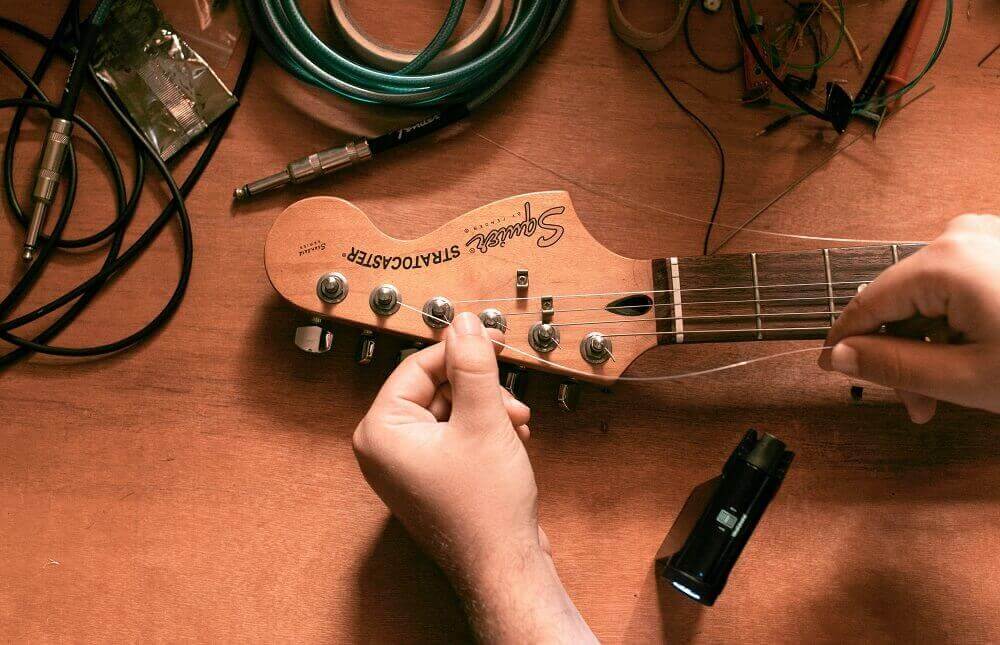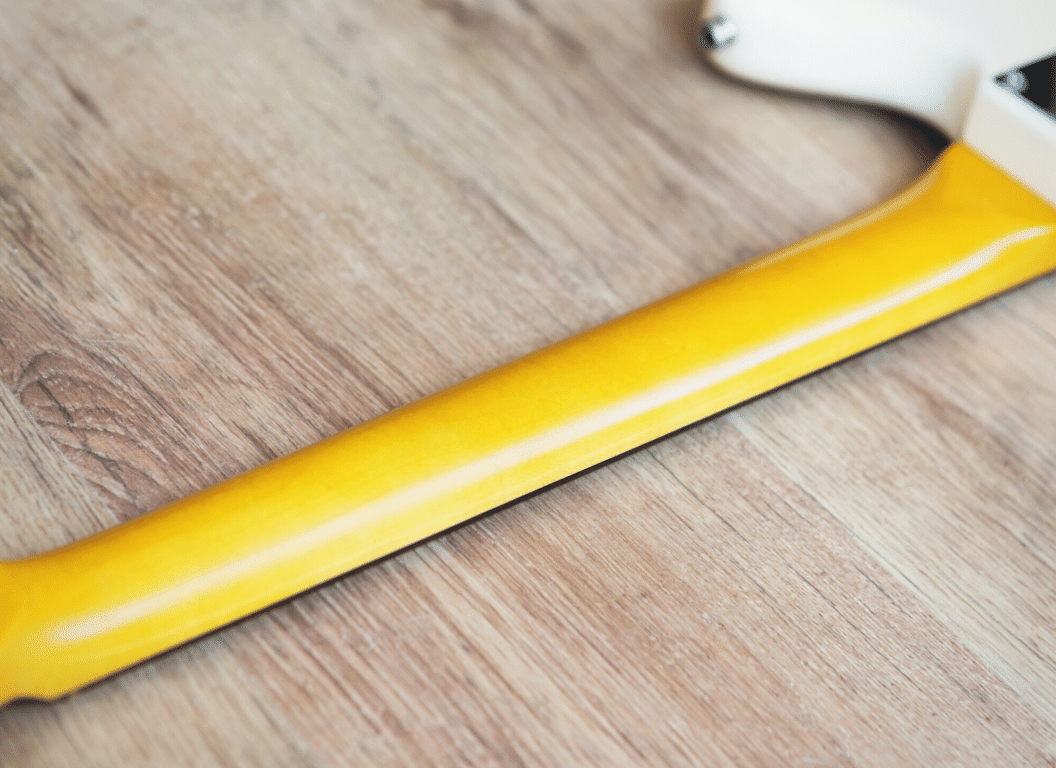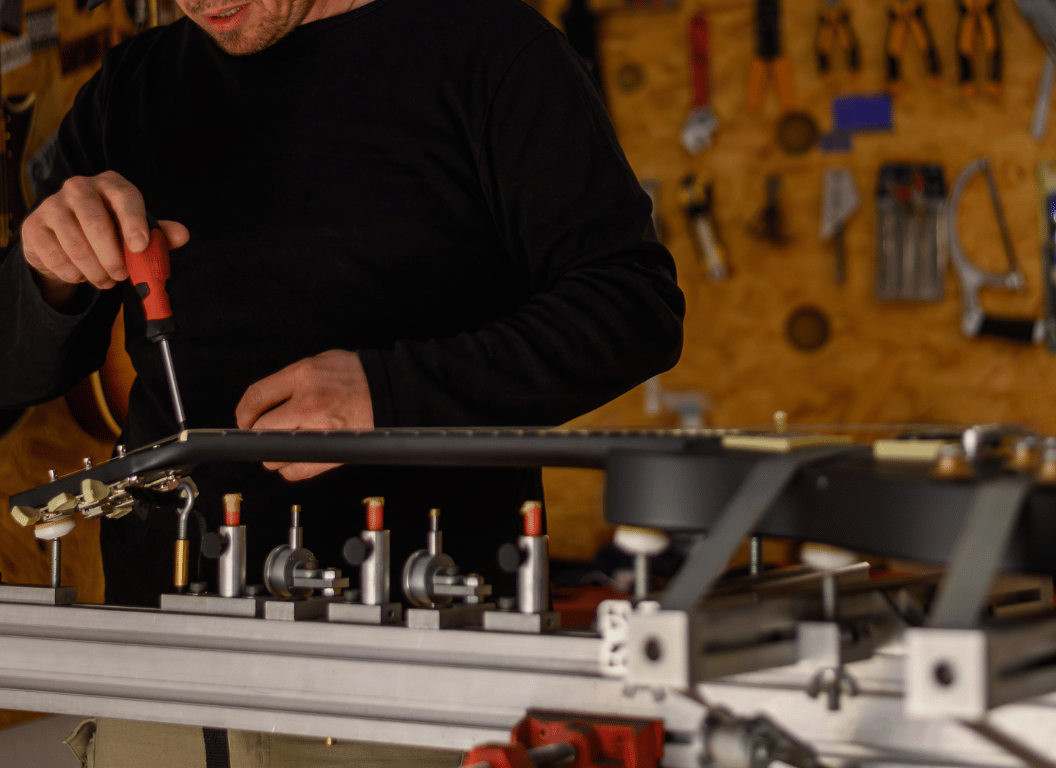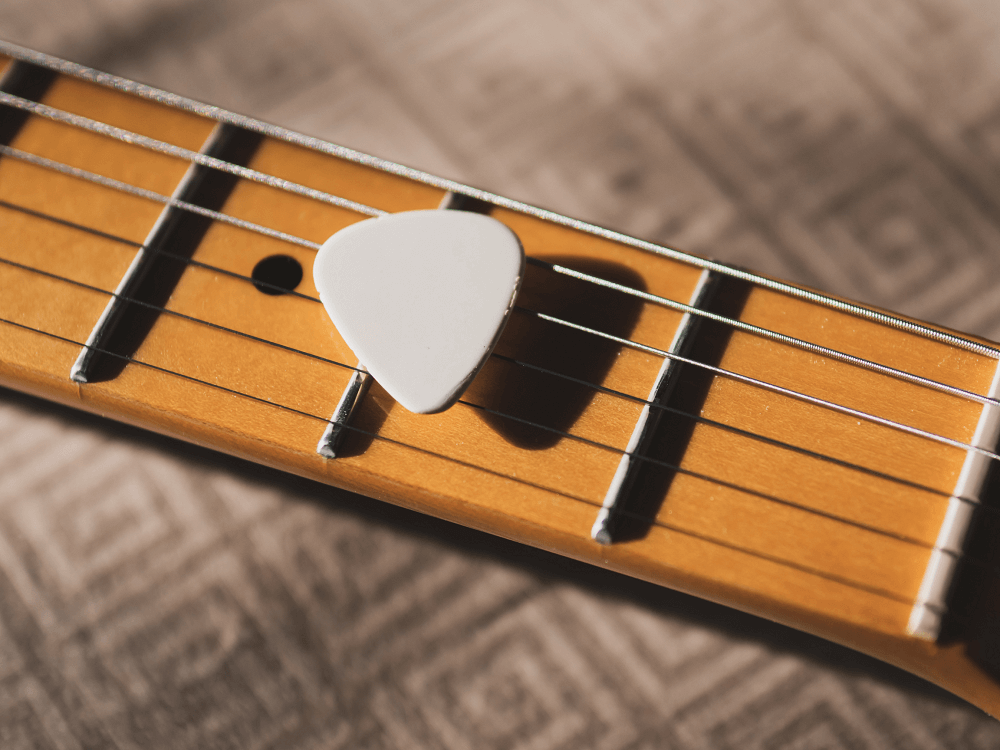How do you fix a guitar string that popped?
So there we are, we have one string that decided to break all of the sudden, what do we do?
Do we just buy a new set of strings and replace them all? Do we just replace that one string that broke? Is there any way to actually fix a string?
These are all some of the questions that people usually have and also find themselves getting told different opinions online.
In this article, I will give you the answer to those questions and show you two different ways to get this problem fixed by yourself without the need of calling or taking your guitar anywhere.
Aside from this, I will also mention a few tips that you can start implementing today that will prevent your strings from breaking so easily.
Let’s get started!
Table of Contents
How to fix a guitar string that popped?
The quick answer is that, in order to fix a string that popped, you will need to first check where exactly the string broke and assess whether it’s better to simply replace just the broken string or all the strings at once. After you made that decision, then start by removing the broken string, fixing it if possible and necessary, and attempt to put it back in tune. At this point, check if your fix is safe, stable, and secure. If not, then either get a new string or replace your whole set.
Again, there are usually two different ways to go about fixing a popped string on any typical guitar:
- Removing and replacing all the strings of your guitar at once
- Changing and replacing the broken string only
The very first step in this whole process is assessing and deciding which of the two you want to do!
But how do you do this?
Well, let’s start by asking yourself this question, where did the string break?
Replacing the broken guitar string is very simple and easy, but it won’t help much if it’s broken in the wrong spot.
There could be 3 potential answers to that question:
- When your string breaks behind your guitar nut.
- When it breaks close to your guitar bridge.
- And lastly when the string breaks right in the middle of your fretboard.
Now, let’s say that you play an acoustic guitar and your string breaks very close to your guitar bridge.
If you’re one of those that cut the remaining portion of your strings like this:
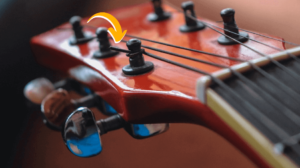
Then, this most likely won’t apply to you, but if you always leave extra string length just in case something happens, then you might be able to just use the longer part as your entire string from now on.
Again, this is if your string breaks very close to your guitar bridge, otherwise, there might not be enough string length to the extent that it’s useful to you again.
Now, another scenario can be when your string breaks behind your guitar nut, somewhere around here:
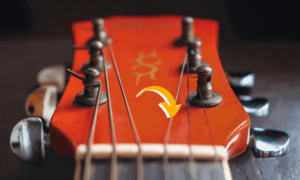
It’s possible for you, with the help of some pliers, to bend the remaining parts into a hook, and re-attach them again.
This should only be done with steel strings!
It would be something like this:
On the other side, if you have nylon strings, the closest helpful solution that is usually recommended is to do a double sheet bend:
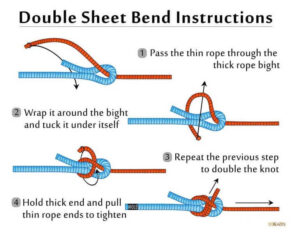 Source: 101knots.com
Source: 101knots.com
This type of knot is one of those that gets tighter the more you pull each side apart.
Which if you think about it, is perfect for something like fixing a string, since when we tune our instrument and put pressure into the string, we’re literally pulling the string apart to change its pitch.
Now, while these two solutions are possible, I wouldn’t recommend doing them at all!
I’ll say it again, I do NOT recommend you do this, and this is why…
Remember when I mentioned checking if what you do is safe, stable, and secure?
Well, this is quite the complete opposite of that since your guitar will not stay in tune for the most part and you’re increasing the chances of it breaking again.
I only did this once, and it was one of those days where this was the only way to keep playing my guitar with six complete strings. I also had no replacements and every possible guitar store was closed.
In other words, this is a very short-term and poor way of doing things, but a good alternative if you’re quarantining 😷, for example.
Once you have the opportunity of either replacing the string set or putting a new string to replace the broken one, you should do it!
For this next part, I will be showing you how to properly fix a string that popped in case you have an extra string to replace it with.
To make your life easier, I recommend you have a plier, a peg winder, a screwdriver, and a wire cutter.
Replacing only the broken string:
Step 1: Remove the popped string
You should first remove the broken string wire from the tuning peg; a plier helps you accomplish this very quickly.
If you don’t have a plier, then grab the string with your hand and reverse the string to the point where it allows you to pull it off completely.
At this point, if you have an electric guitar, you will be required to open your guitar backplate using a screwdriver.
If you have an acoustic guitar, then use either a plier or the pin puller part of your peg winder (recommended) to remove the bridge pin.
For those that might not know and is the first time doing something like this, these are your guitar bridge pins:
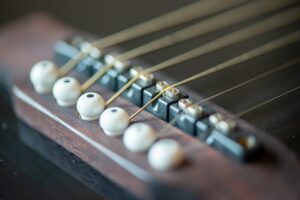
After completely doing this, you should now be able to remove the remaining part of the string.
Step 2: Grab the new string and connect it to your guitar bridge
Just like the step before, what you’ll do now depends on whether you have an acoustic or an electric guitar.
For acoustic guitars, you need to insert the ring end of the string into the peg holes.
At the same time, while putting the bridge pins, you have to ensure that the furrow on that said bridge pin is placed in such a way that it confronts the string.
From that point forward, you can either do the same thing to the other strings or finish them one by one.
For electric guitars, the same thing applies, but the only difference will be the opening and closing of your guitar backplate using a screwdriver.
Step 3: Tie the string into the tuning peg
Now that your strings are connected to your guitar bridge, is time to tie them to their respective tuning peg.
While doing so, you should have enough slack in the string to allow various windings around the peg before adding pressure to the string.
After you do this, start turning the pegs to begin tuning your guitar strings.
This could take a while since your strings will start stretching up to the point where it can feel like you’re not making any progress, but slowly and steadily they will start staying on the same pitch for longer periods of time.
As a rule of thumb, you can also stretch the strings yourself by using your hands before you tune the strings.
Step 4: Cut the remaining extra string
This is a very important step in my opinion.
If you remember what we talked about before, you must know that this will dictate whether or not you will potentially be able to fix a broken string in the future.
In my case, I always cut the remaining extra string!
Looks better and it just looks better! (I meant to say it twice 🤣).
There’s a huge difference between this:

Which as you can see has every guitar string wrapped in a non-aesthetically pleasing circle.
And something like this:

Whenever a string breaks, I just usually have a replacement somewhere around the house or replace the entire set by buying a new package.
Pro Tip: Always keep your used guitar strings for at least 6 months after you replace them so that if one of the new ones breaks, chances are, you will always have an old string that you can use to fix it.
Cut the extra string as close as possible to the tuning peg, but don’t exaggerate, 0.3 inches should be enough.
And once again, remember that you may need to tune the guitar several times later again as new strings tend to expand after some time.
Replacing all the strings of the guitar:
In case you chose to simply replace all of your guitar strings at once, then the steps that you must follow should be the same as the ones we just mentioned before.
This time, though, I would recommend that once you remove all the strings, you actually take some time to clean your guitar, specifically your guitar fretboard.
Read: How To Clean A Guitar Fretboard With Household Items?
As I said, the step-by-step is pretty much the same, but rather than repeating what we just covered, I thought it would be really helpful for you if you watch these two YouTube videos.
The first one is for those guitarists who own an acoustic guitar:
By the way, you will notice that he’s using a lot of different tools like pliers, an actual peg winder, and a wire cutter.
I found this product on Amazon that literally has all 3 tools built-in as just one single tool.
It’s called a String Winder Cutter and Bridge Pin Puller 3 in 1 Guitar Tool:
This product is a very clever and cheap alternative to either buying or looking for all the other single tools separately.
In my opinion, a must-have!
Now, this next video is for those guitar players with electric guitars:
And lastly, just to be extra helpful…
This is another video for those who are changing the strings on a classical guitar:
How to prevent your strings from breaking too soon?
So you’ve finally fixed your guitar and you’re able to play again.
How do you prevent other strings from breaking in the future? What type of care or maintenance would be necessary for them to be in better shape.
These are some tips that you should start implementing as soon as possible so that your strings could potentially last longer than usual:
-
Regularly check the condition of your guitar strings
Is no secret that regularly checking the condition of your strings will help them last longer as it will allow you to take the necessary precautions right on time.
In other words, if you are not willing to clean your entire guitar every time after you play it, then at least check its condition once a week, or whenever you consider it a must.
This will give you the opportunity to notice small details that must be taken care of before they turn into something big.
You might think that with a little bit of sweat on your fingers, the damage can’t be that bad.
And this isn’t necessarily wrong, but with time, the natural oils of your skin will mix with the dust and dirt that is naturally part of your environment, and then it becomes grime.
Throughout this process, your guitar tone and intonation will be affected to a higher degree.
-
Clean your strings as often as possible
Just like regularly checking the condition of your guitar strings, actually cleaning your strings as often as possible could be twice as beneficial.
Doing this will ensure 2 things:
- The first one is that you will simply prevent your room dust to mix with your natural finger oils.
- And the second one is that your guitar strings will stay smooth for a longer period of time.
Have you ever played any guitar that hasn’t been played in a long time? Did the strings feel different or hard in a way?
Well, that’s most likely because, as we said before, with time, the natural oils of your skin will mix with the dust and dirt that is naturally part of your environment, and then it becomes grime.
This grime would literally get in the way of your fingers!
When doing guitar techniques such as ‘slides’ and ‘string vending’, or just simply the changing of chords, you will feel as if somebody is pulling you back and stopping you from playing fast and precisely.
By cleaning your strings frequently, you will put the odds in your favor for nothing of this to happen and for your strings’ lifetime to be longer.
-
Be aware of your guitar pick and how much force you use when playing
This is another reason why your guitar strings might be breaking and you might have not even noticed it yet.
A different number of factors play into this:
- How big and heavy is your guitar pick?
- How much force are you using when playing?
- Where exactly are you positioning your hand to pick the string?
If you’re particularly making use of big and heavy picks, the force that you’ll apply to the strings when you play your guitar will be higher.
A little bit of science will tell us with Newton’s second law, that:
With being force,
being mass of an object, and
being acceleration.
In other words, bigger picks mean your chances of breaking a string will increase.
Let’s take a look at some picks examples:
With this first image, we can take a look at probably the most regular pick you will ever find!
One solid color, a simple design, and what it looks like soft plastic material.

With our second example, we can see almost the total opposite of what we just saw.
A more complex design, also one solid color, and definitely a guitar pick with a bigger volume.
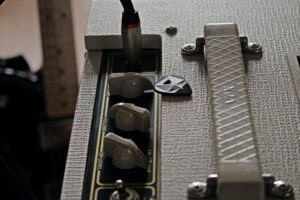
Just from these two pictures, we can safely assume that the second example is more likely to damage your strings if not used properly.
Also like we said before, asking yourself where exactly you’re positioning your hand to pick the strings is important.
Playing and picking your strings closer to the guitar bridge will shoot up the chance of breakage since they will have less flexibility with each pluck, and less distance to travel and vibrate.
I encourage you to watch this YouTube video uploaded by Stringjoy:
If you’re still looking for a second opinion on this topic or want to know a few more other recommendations on how to prevent your strings from breaking, then this video is a must-watch.
Aside from giving you a different perspective and point of view on what we just talked about, it will also help you understand in a more visual way, what some of the places where strings tend to break are.
Should you replace all the strings or just the one that has popped?
This is really one of the first questions that people usually have in such a scenario.
In order to give you the best answer to this question, I would honestly have to know more details about where the string actually broke, how old your guitar strings are, and whether or not you have new strings laying around your house.
At the same time, it also depends on how often you used these strings before one of them broke, and even how long you’re planning on using them after you fix the damage yourself.
Because chances are, the same string will break again sooner or later 🙁
Maybe you don’t mind spending the extra money to just get a new set of strings, or you bought the ones that just broke, very recently.
I do understand that it can be very upsetting!
While changing all the strings of your guitar will give you the peace of mind that you will for sure not face this problem again in the near future, your guitar will also sound much better with brand new strings.
On the other hand, if you feel that your other strings are in decent condition, then there is no need to replace them all.
By just fixing the one that has popped out instead of changing the entire strings you will save both time and money.

Dad, husband, son, and guitarist. I’ve been playing guitar for 20 years. Passion for writing, painting, and photography. I love exploring nature, and spending time with my family. Currently have a Gretsch G5220 Electric Guitar as my main instrument.

